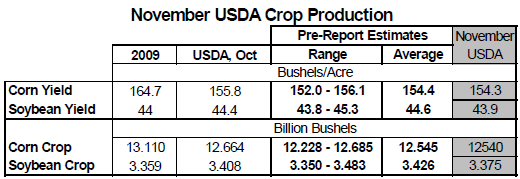



CME: USDA Reports Show Changes in Corn Usage
US - If it's not one thing then it's another for grain buyers, write Steve Meyer and Len Steiner.Today’s USDA Crop Production and World Agricultural Supply and Demand Estimates reports confirm that quite clearly. The actual yield and crop forecasts from today’s report have been added to yesterday’s table of pre-report estimates in the table below.

The one thing it’s not is another surprise to the down side for USDA's forecast of the national corn yield and crop. USDA’s November estimate of the corn yield is 154.3 bushels/acre, down 1.5 bushels from last month but only 0.1 bushels lower than the average of analysts’ predictions. That yield led to a crop forecast very close to analysts’ average prediction since USDA did not change acreages from the levels of the October report. The predicted 12.54 billion bushel crop is 4.3 per cent smaller than the 2010 crop.
What USDA did change was corn usage (see the Supply and Utilization (S&U) table below). They reduced total corn usage by 50 million bushels by dropping projected feed/residual usage by 100 million bushels and exports by 50 million bushels while increasing projected ethanol usage by 100 million bushels. The increase for ethanol is understandable given good ethanol margins. The reduction of exports is a bit riskier in our opinion. While YTD shipments are down 4 per cent, outstanding sales are up sharply from last year and the dollar is falling and, we think, fixing to fall more given the Fed’s big bond purchase last week. The last two factors clearly suggest more exports, not less. This is a key corn usage category to monitor in coming weeks and months. Finally, the drop in feed/residual continues, to some degree, the “old-crop or new-crop” debate that began back in September. We thought USDA’s increase was quite large last month but really wrote it off to higher feed usage of the 2010-11 crop that actually occurred in the 2009-10 crop year. Is this reduction a fine-tuning of the crop year shift or a real belief that livestock feeders will use less? It is indeed likely that cattle will use less corn next year. Ditto for hogs given the shift in profit projections. The broiler industry is growing at present but these rising feed costs — and especially this report’s estimates for soybeans (see below) — have to give the chicken guys cause for some concern, do they not? How (or whether) Tyson, Pilgrim’s (or, more important, JBS — which announced today that it had increased its stake in Pilgrim’s to 67 per cent), Sanderson an others react will have impacts on both the grain and meat markets in the year to come.

The changes put the projected 2011 stocks-to-use ratio for corn at 6.2 per cent, second only to the 5 per cent S/U ration we saw in 1996.
Roseanne’s “another” thing in this situation is the soybean market, the source of this month’s salvo aimed at livestock and poultry industry profits. USDA surprised the market with it’s reduction of the estimated national soybean yield from last month’s 44.4 bushels per acre to 43.9 bushels this month. Analysts had actually expected the average yield to increase slightly, no doubt influenced by stories from all around the country alluding to very good soybean yields. But USDA’s objective data says different and the result was a 33 million bushel reduction in the forecast 2010 soybean crop. As it did for corn, USDA here again left acreage figures unchanged from October.
Add in a 50 million bushel increase for forecast exports and year-end soybean stocks went from a snug-but-not-a-problem 265 million bushels to an uncomfortably tight 185 million bushels in a heartbeat. Projected exports of 1.57 billion bushels are 4.6 per cent higher than last year. Early shipments suggest that the new USDA number could be conservative, though. 2010/11 shipments are up 53 per cent from last year through October. That pace could obviously slow but here again, a weak US dollar will push exports higher while a still-strong Real will hinder competition from Brazil.
USDA did increase projected soybean output for both Argentina (2mmt higher than October, to 52mmt) and Brazil (up 0.5 mmt from October to 67.5mmt) but readers should note that both of those output levels are lower than last year — Argentina by 4.5mmt and Brazil by 1.5mmt. That means that, at this point, fewer beans will be available come March and April, keeping export interest in US supplies high. The best hope for affordable bean meal is continued strength in soy oil.








